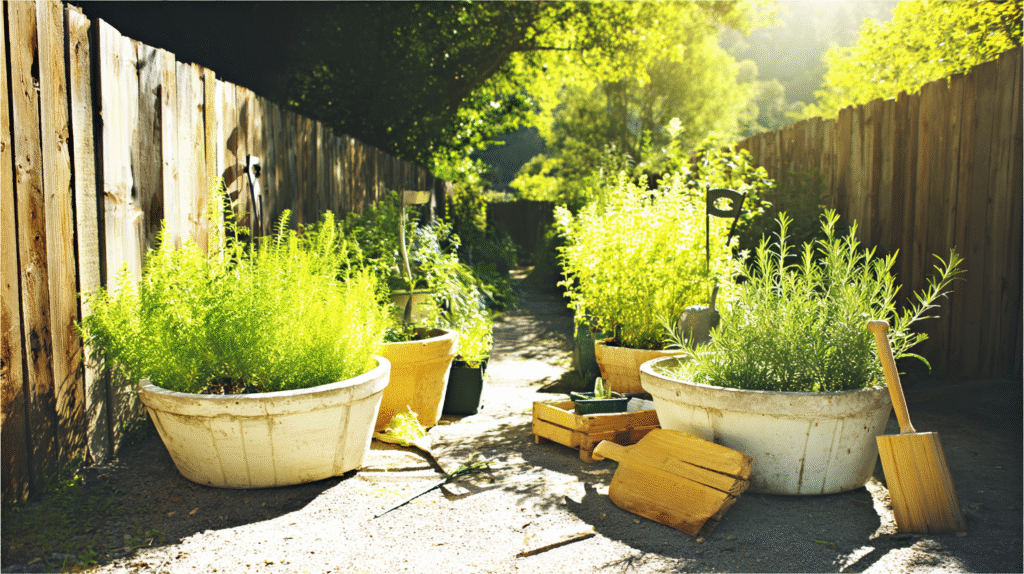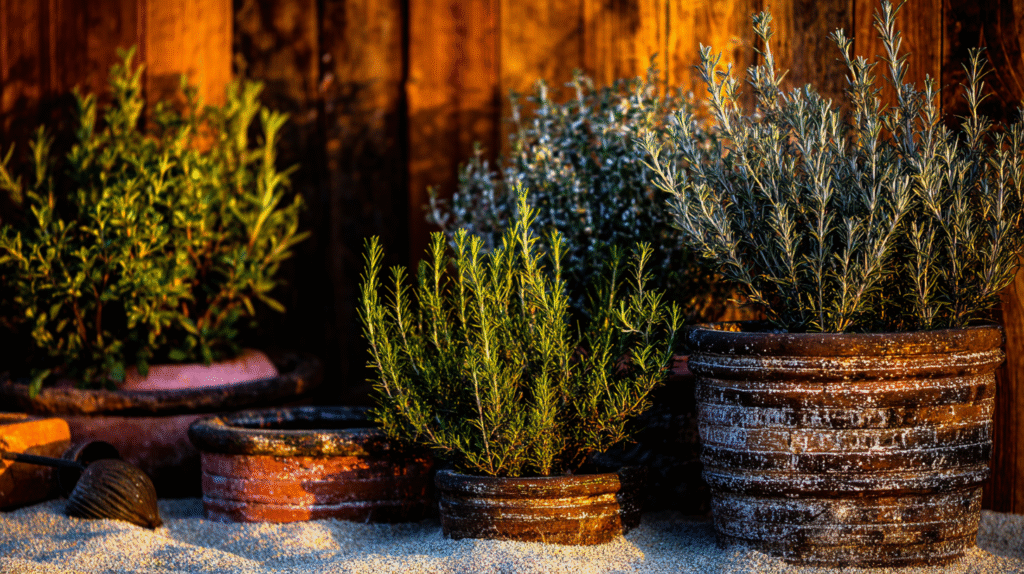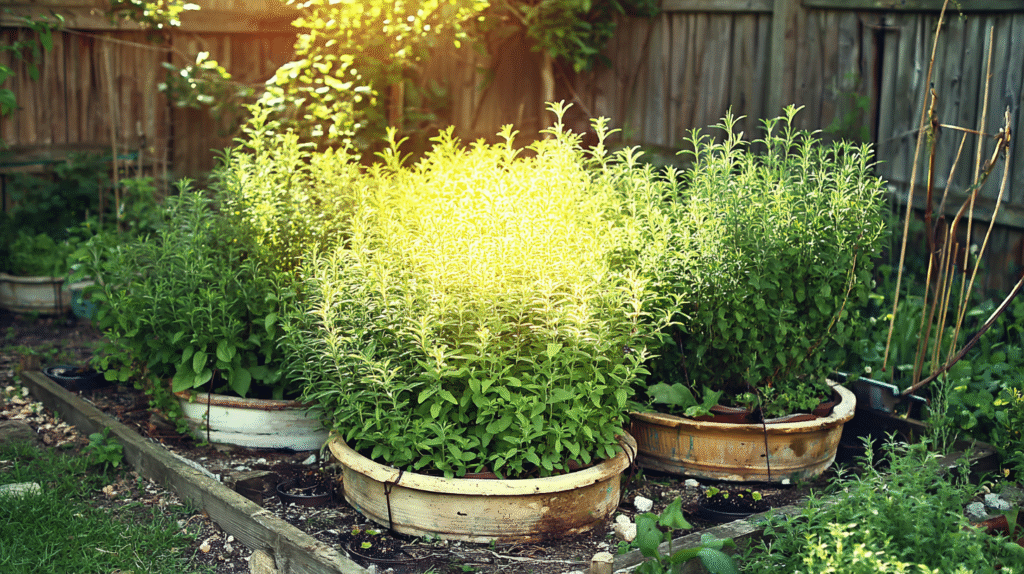My backyard used to be where herbs went to die. Over two years, I murdered at least eight rosemary plants and countless thyme varieties. They’d look great at the nursery, survive maybe a month, then turn into crispy brown sticks that mocked my gardening ambitions.
The breaking point came when my Italian neighbor looked over the fence at my latest casualties and said, “You’re loving them to death, cara.” She was right. I was treating Mediterranean herbs like they were needy houseplants instead of the tough, drought-loving survivors they actually are.
Fast forward three years, and that same corner of my yard looks like a piece of Tuscany. Rosemary bushes tower three feet tall, and thyme carpets spill over rock walls. The secret? I stopped trying so hard and started understanding what these herbs actually want.

The Murders That Taught Me Everything
Let me detail my failures, because they’re probably your failures too:
Death by Drowning: My first four rosemary plants died from root rot. I watered them like tomatoes — deeply and regularly. Turns out rosemary would rather be neglected than nurtured.
Death by Soil: Planted them in my “premium” garden soil, rich with compost and nutrients. They hated it. These herbs want poor, gravelly soil that would make other plants weep.
Death by Shade: Stuck them in a “partial sun” spot because full sun seemed cruel. They stretched, weakened, and eventually gave up. These plants worship the sun like ancient Greeks.
Death by Winter: Left them in soggy clay soil over winter. Spring revealed black, mushy stems. Drainage isn’t optional — it’s life or death.
The Soil Revolution That Changed Everything
After consulting my Italian neighbor (Maria, now my herb guru), I learned these herbs don’t want “good” soil. They want Mediterranean soil — poor, rocky, and fast-draining.
My game-changing mix:
- 40% native soil (even if it’s terrible)
- 30% coarse sand
- 20% perlite or pumice
- 10% compost (maximum!)
- Handful of limestone gravel
The drainage test: Pour water on your prepared soil. If it doesn’t drain within 30 seconds, add more sand and perlite. I went through three bags of perlite getting this right.
The raised bed revelation: Built simple raised beds with rocks I found on Craigslist for free. Instant drainage improvement. My herbs went from surviving to thriving within one season.

Location: Why Full Sun Actually Means FULL Sun
These herbs want sun like I want coffee — constantly and in unreasonable amounts.
Where they failed:
- “Bright” spot that got 4 hours of sun = leggy, weak growth
- Morning sun only = survived but never thrived
- Dappled shade = slow death
Where they exploded with growth:
- South-facing slope with 8+ hours of direct sun
- Against hot brick wall with reflected heat
- Rocky hillside that bakes in afternoon sun
My massive rosemary bush grows against a south-facing wall that gets so hot I can’t touch it in summer. The plant loves it. These aren’t delicate herbs — they’re solar panels with roots.
Watering: The Less-Is-More Philosophy
This was my hardest lesson. Every instinct said to water more. The plants begged me to water less.
My current watering reality:
- Newly planted: Weekly for first month only
- Established rosemary: Every 2-3 weeks in summer
- Established thyme: Every 2 weeks in peak heat
- Winter: Maybe monthly if no rain
- Spring/Fall: Let rain handle it
The finger test: Stick your finger deep in the soil. Still moist at 3 inches? Don’t even think about watering. Bone dry throughout? Maybe water tomorrow.
The drought test: Last summer, I forgot to water my established rosemary for six weeks during a heat wave. It looked exactly the same. Meanwhile, my pampered basil died of thirst in three days.
Varieties That Actually Survive (And Ones That Don’t)
Rosemary winners:
- ‘Tuscan Blue’: My 4-foot monster, incredibly hardy
- ‘Arp’: Survived 15°F winter with no protection
- ‘Hill Hardy’: Lives up to its name
- Generic nursery rosemary: Surprisingly tough
Rosemary losers:
- ‘Prostrate’ in clay soil: Rotted immediately
- Any rosemary in a pot I forgot to bring in: Frozen
Thyme champions:
- Common thyme: Unkillable once established
- ‘Silver Queen’: Beautiful and bulletproof
- Lemon thyme: Spreads everywhere (in a good way)
- Creeping thyme: Perfect for paths
Thyme failures:
- Woolly thyme in my wet corner: Melted
- Any thyme in rich soil: Grew fast, tasted like nothing

The Pruning Fear I Had to Overcome
I was terrified to prune, thinking I’d kill them. Turns out, not pruning was killing them.
Rosemary pruning reality:
- Prune after flowering (or spring if no flowers)
- Can remove up to 1/3 without issues
- Never cut into old woody stems
- Shape pruning = bushier growth
The accident that taught me: Dog broke a huge branch off my rosemary. I almost cried. Plant responded by growing three times bushier. Now I prune confidently.
Thyme pruning:
- Shear back by half after flowering
- Or whenever it looks scraggly
- Seriously, you can’t hurt established thyme
- More pruning = more growth
Winter: The Make or Break Season
Lost so many herbs to winter before learning these tricks:
For borderline zones:
- Mulch with gravel, not wood (stays drier)
- Improve drainage before winter hits
- Don’t fertilize after August
- Let them harden off naturally
My zone 6b solutions:
- South-facing walls for tender varieties
- Rock mulch reflects heat
- Windbreaks for exposed plants
- Accept some losses, plan replacements
The potted plant shuffle: Rosemary in pots comes into the garage when temps hit 20°F. Not ideal, but they survive until spring.
Propagation: Infinite Free Plants
Once established, these herbs want to multiply:
Rosemary cuttings:
- 4-6 inch stems in spring
- Strip lower leaves
- Dip in rooting hormone (optional)
- Stick in sandy soil
- Ignore for 6 weeks
- Success rate: 70%
Thyme division:
- Dig up clump in spring
- Literally tear apart
- Replant pieces
- Water once
- Success rate: 95%
I’ve created an entire hedge from one original rosemary plant. Given away dozens of thyme starts. These plants are generous once happy.
The Companion Planting Discovery
Tried the whole herb garden thing — basil, parsley, cilantro mixed with Mediterranean herbs. Disaster. Different water needs killed half of everything.
What works together:
- Rosemary + thyme + oregano + sage
- Lavender as a border
- Santolina for silver contrast
- Society garlic for pest control
Keep separate:
- Mint (invasive and water-hungry)
- Basil (needs rich soil and water)
- Parsley (wants more water)
- Cilantro (different everything)
My Mediterranean corner is now its own ecosystem. Everything has similar needs, so I can ignore the whole area equally.
The Mistakes That Still Haunt Me
The fertilizer fiasco: Fed rosemary with tomato fertilizer. Grew lush and green… and tasted like grass. These herbs develop flavor through struggle, not pampering.
The container catastrophe: Beautiful glazed pots with “drainage holes” that didn’t actually drain. Lost three established plants to root rot before switching to ugly but effective terracotta.
The mulch mistake: Wood mulch around Mediterranean herbs holds moisture. Switched to pea gravel. Game changer.
Why This Corner Is Now My Favorite
Three years ago, this was my failure corner. Now it’s where I go to feel accomplished. The rosemary is head-high and blooming. The thyme forms a living carpet that smells amazing when walked on. I haven’t bought dried herbs in two years.
But more than that — I learned to work with nature instead of against it. These plants taught me that sometimes the best care is the least care. That poor soil can be perfect soil. That neglect can be nurturing.
My Italian neighbor now asks ME for cuttings. Last week, she said my rosemary looked better than her sister’s in Tuscany. I think she was being kind, but I’ll take it.
The herb graveyard is now a Mediterranean paradise. All it took was understanding that these plants don’t want to be coddled — they want to be challenged. Give them sun, drainage, and space to struggle, and they’ll reward you with more herbs than you can possibly use.
Just maybe start with one plant instead of eight. Learn from my expensive mistakes. Your wallet and your cooking will thank you. 🌿






